1. Cui Q, Liu YS, Li DF, et al. Cemented hip hemiarthroplasty clinical observations on unstable intertrochanteric fracture in elderlies. Eur J Trauma Emerg Surg. 2016; 42:651–656. PMID:
26351080.

2. Kim SY, Kim YG, Hwang JK. Cementless calcar-replacement hemiarthroplasty compared with intramedullary fixation of unstable intertrochanteric fractures. A prospective, randomized study. J Bone Joint Surg Am. 2005; 87:2186–2192. PMID:
16203881.
3. Ju DG, Rajaee SS, Mirocha J, Lin CA, Moon CN. Nationwide analysis of femoral neck fractures in elderly patients: a receding tide. J Bone Joint Surg Am. 2017; 99:1932–1940. PMID:
29135667.
4. Mansukhani SA, Tuteja SV, Kasodekar VB, Mukhi SR. A comparative study of the dynamic hip screw, the cemented bipolar hemiarthroplasty and the proximal femoral nail for the treatment of unstable intertrochanteric fractures. J Clin Diagn Res. 2017; 11:RC14–RC19. PMID:
28571221.

5. Luo X, He S, Zeng D, Lin L, Li Q. Proximal femoral nail antirotation versus hemiarthroplasty in the treatment of senile intertrochanteric fractures: case report. Int J Surg Case Rep. 2017; 38:37–42. PMID:
28734187.

6. Grimsrud C, Monzon RJ, Richman J, Ries MD. Cemented hip arthroplasty with a novel cerclage cable technique for unstable intertrochanteric hip fractures. J Arthroplasty. 2005; 20:337–343. PMID:
15809952.

7. Sidhu AS, Singh AP, Singh AP, Singh S. Total hip replacement as primary treatment of unstable intertrochanteric fractures in elderly patients. Int Orthop. 2010; 34:789–792. PMID:
19517109.

8. Zuckerman JD. Hip fracture. N Engl J Med. 1996; 334:1519–1525. PMID:
8618608.

9. Jensen JS. Trochanteric fractures. An epidemiological, clinical and biomechanical study. Acta Orthop Scand Suppl. 1981; 188:1–100. PMID:
6939295.
10. Yang S, Liu Y, Yang T, Zou J, Yang H. Early clinical efficacy comparison study of Gamma3 nail, percutaneous compression plate (PCCP) and femoral head replacement (FHR) treatment on senile unstable intertrochanteric fractures. J Invest Surg. 2018; 31:130–135. PMID:
28340311.

11. Göçer H, Coşkun S, Karaismailoğlu N. Comparison of treatment of unstable intertrochanteric fracture with different arthroplasty methods. Niger Med J. 2016; 57:81–85. PMID:
27226680.
12. Tice A, Kim P, Dinh L, Ryu JJ, Beaulé PE. A randomised controlled trial of cemented and cementless femoral components for metal-on-metal hip resurfacing: a bone mineral density study. Bone Joint J. 2015; 97-B:1608–1614. PMID:
26637673.
13. Cankaya D, Ozkurt B, Tabak AY. Cemented calcar replacement versus cementless hemiarthroplasty for unstable intertrochanteric femur fractures in the elderly. Ulus Travma Acil Cerrahi Derg. 2013; 19:548–553. PMID:
24347215.
14. Langslet E, Frihagen F, Opland V, Madsen JE, Nordsletten L, Figved W. Cemented versus uncemented hemiarthroplasty for displaced femoral neck fractures: 5-year followup of a randomized trial. Clin Orthop Relat Res. 2014; 472:1291–1299. PMID:
24081667.

15. Liberati A, Altman DG, Tetzlaff J, et al. The PRISMA statement for reporting systematic reviews and meta-analyses of studies that evaluate health care interventions: explanation and elaboration. J Clin Epidemiol. 2009; 62:e1–e34. PMID:
19631507.

16. Higgins JP, Thompson SG, Deeks JJ, Altman DG. Measuring inconsistency in meta-analyses. BMJ. 2003; 327:557–560. PMID:
12958120.

17. Thakkar CJ, Thakkar S, Kathalgere RT, Kumar MN. Calcar femorale grafting in the hemiarthroplasty of the hip for unstable inter trochanteric fractures. Indian J Orthop. 2015; 49:602–609. PMID:
26806966.

18. Kumar Gn K, Meena S, Kumar N V, S M, Raj Mk V. Bipolar hemiarthroplasty in unstable intertrochanteric fractures in elderly: a prospective study. J Clin Diagn Res. 2013; 7:1669–1671. PMID:
24086870.
19. Abdelkhalek M, Ali AM, Abdelwahab M. Cemented bipolar hemiarthroplasty with a cerclage cable technique for unstable intertrochanteric hip fractures in elderly patients. Eur J Orthop Surg Traumatol. 2013; 23:443–448. PMID:
23412149.

20. Karthik K, Natarajan M. Unstable trochanteric fractures in elderly osteoporotic patients: role of primary hemiarthroplasty. Orthop Surg. 2012; 4:89–93. PMID:
22615153.

21. Sinno K, Sakr M, Girard J, Khatib H. The effectiveness of primary bipolar arthroplasty in treatment of unstable intertrochanteric fractures in elderly patients. N Am J Med Sci. 2010; 2:561–568. PMID:
22558568.

22. Rodop O, Kiral A, Kaplan H, Akmaz I. Primary bipolar hemiprosthesis for unstable intertrochanteric fractures. Int Orthop. 2002; 26:233–237. PMID:
12185526.

23. Chan KC, Gill GS. Cemented hemiarthroplasties for elderly patients with intertrochanteric fractures. Clin Orthop Relat Res. 2000; (371):206–215.

24. Park BJ, Cho HM, Min WB. A comparison of internal fixation and bipolar hemiarthroplasty for the treatment of reverse oblique intertrochanteric femoral fractures in elderly patients. Hip Pelvis. 2015; 27:152–163. PMID:
27536619.

25. Park MS, Cho HM, Kim JH, Shin WJ. Cementless bipolar hemiarthroplasty using a rectangular cross-section stem for unstable intertrochanteric fractures. Hip Int. 2013; 23:316–322. PMID:
23760747.

26. Lee YK, Ha YC, Chang BK, Kim KC, Kim TY, Koo KH. Cementless bipolar hemiarthroplasty using a hydroxyapatite-coated long stem for osteoporotic unstable intertrochanteric fractures. J Arthroplasty. 2011; 26:626–632. PMID:
20637559.

27. Kayali C, Agus H, Ozluk S, Sanli C. Treatment for unstable intertrochanteric fractures in elderly patients: internal fixation versus cone hemiarthroplasty. J Orthop Surg (Hong Kong). 2006; 14:240–244. PMID:
17200522.

28. Sancheti KH, Sancheti PK, Shyam AK, Patil S, Dhariwal Q, Joshi R. Primary hemiarthroplasty for unstable osteoporotic intertrochanteric fractures in the elderly: a retrospective case series. Indian J Orthop. 2010; 44:428–434. PMID:
20924485.

29. Fan L, Dang X, Wang K. Comparison between bipolar hemiarthroplasty and total hip arthroplasty for unstable intertrochanteric fractures in elderly osteoporotic patients. PLoS One. 2012; 7:e39531. PMID:
22745778.

30. Suh YS, Nho JH, Kim SM, Hong S, Choi HS, Park JS. Clinical and radiologic outcomes among bipolar hemiarthroplasty, compression hip screw and proximal femur nail antirotation in treating comminuted intertrochanteric fractures. Hip Pelvis. 2015; 27:30–35. PMID:
27536599.

31. Kim Y, Moon JK, Hwang KT, Choi IY, Kim YH. Cementless bipolar hemiarthroplasty for unstable intertrochanteric fractures in octogenarians. Acta Orthop Traumatol Turc. 2014; 48:424–430. PMID:
25230266.

32. Choy WS, Ahn JH, Ko JH, Kam BS, Lee DH. Cementless bipolar hemiarthroplasty for unstable intertrochanteric fractures in elderly patients. Clin Orthop Surg. 2010; 2:221–226. PMID:
21119938.

33. Celiktas M, Togrul E, Kose O. Calcar preservation arthroplasty for unstable intertrochanteric femoral fractures in elderly. Clin Orthop Surg. 2015; 7:436–442. PMID:
26640625.

34. Chang JD, Kim IS, Lee SS, Yoo JH, Hwang JH. Unstable intertrochanteric versus displaced femoral neck fractures treated with cementless bipolar hemiarthroplasty in elderly patients; a comparison of 80 matched patients. Orthop Traumatol Surg Res. 2016; 102:695–699. PMID:
27234871.

35. Wada K, Mikami H, Oba K, Yonezu H, Sairyo K. Cementless calcar-replacement stem with integrated greater trochanter plate for unstable intertrochanteric fracture in very elderly patients. J Orthop Surg (Hong Kong). 2017; 25:2309499016684749. PMID:
28139187.

36. Camurcu Y, Cobden A, Sofu H, Saklavci N, Kis M. What are the determinants of mortality after cemented bipolar hemiarthroplasty for unstable intertrochanteric fractures in elderly patients? J Arthroplasty. 2017; 32:3038–3043. PMID:
28550964.

37. Shen J, Wang DL, Chen GX, et al. Bipolar hemiarthroplasty compared with internal fixation for unstable intertrochanteric fractures in elderly patients. J Orthop Sci. 2012; 17:722–729. PMID:
22868700.

38. Desteli EE, Ímren Y, Erdoğan M, Aydagün Ö. Quality of life following treatment of trochanteric fractures with proximal femoral nail versus cementless bipolar hemiarthroplasty in elderly. Clin Invest Med. 2015; 38:E63–E72. PMID:
25864998.

39. Singh S, Shrivastava C, Kumar S. Hemi replacement arthroplasty for unstable inter-trochanteric fractures of femur. J Clin Diagn Res. 2014; 8:LC01–LC04.

40. Gu GS, Li YH, Yang C. Bipolar hemiarthroplasty with a two-step osteotomy technique for unstable intertrochanteric fracture in senile patients. Chin J Traumatol. 2013; 16:103–106. PMID:
23540899.
41. Gu GS, Wang G, Sun DH, Qin DM, Zhang W. Cemented bipolar hemiarthroplasty with a novel cerclage cable technique for unstable intertrochanteric hip fractures in senile patients. Chin J Traumatol. 2008; 11:13–17. PMID:
18230285.

42. Green S, Moore T, Proano F. Bipolar prosthetic replacement for the management of unstable intertrochanteric hip fractures in the elderly. Clin Orthop Relat Res. 1987; (224):169–177.

43. Thakur A, Lal M. Cemented hemiarthroplasty in elderly osteoporotic unstable trochanteric fractures using fracture window. Malays Orthop J. 2016; 10:5–10. PMID:
28435540.
44. Miyamoto RG, Kaplan KM, Levine BR, Egol KA, Zuckerman JD. Surgical management of hip fractures: an evidence-based review of the literature. I: femoral neck fractures. J Am Acad Orthop Surg. 2008; 16:596–607. PMID:
18832603.

45. Koval KJ, Zuckerman JD. Hip Fractures: II. Evaluation and treatment of intertrochanteric fractures. J Am Acad Orthop Surg. 1994; 2:150–156. PMID:
10709003.

46. Broos PL, Vercruysse R, Fourneau I, Driesen R, Stappaerts KH. Unstable femoral neck fractures in young adults: treatment with the AO 130-degree blade plate. J Orthop Trauma. 1998; 12:235–239. discussion 240. PMID:
9619457.

47. Arirachakaran A, Amphansap T, Thanindratarn P, Piyapittayanun P, Srisawat P, Kongtharvonskul J. Comparative outcome of PFNA, Gamma nails, PCCP, Medoff plate, LISS and dynamic hip screws for fixation in elderly trochanteric fractures: a systematic review and network meta-analysis of randomized controlled trials. Eur J Orthop Surg Traumatol. 2017; 27:937–952. PMID:
28434124.

48. Luo X, He S, Li Z, Huang D. Systematic review of cemented versus uncemented hemiarthroplasty for displaced femoral neck fractures in older patients. Arch Orthop Trauma Surg. 2012; 132:455–463. PMID:
22160512.

49. Haentjens P, Casteleyn PP, De Boeck H, Handelberg F, Opdecam P. Treatment of unstable intertrochanteric and subtrochanteric fractures in elderly patients. Primary bipolar arthroplasty compared with internal fixation. J Bone Joint Surg Am. 1989; 71:1214–1225. PMID:
2777850.

50. Kim WY, Han CH, Park JI, Kim JY. Failure of intertrochanteric fracture fixation with a dynamic hip screw in relation to preoperative fracture stability and osteoporosis. Int Orthop. 2001; 25:360–362. PMID:
11820441.

51. Dobbs RE, Parvizi J, Lewallen DG. Perioperative morbidity and 30-day mortality after intertrochanteric hip fractures treated by internal fixation or arthroplasty. J Arthroplasty. 2005; 20:963–966. PMID:
16376248.

52. Fichman SG, Mäkinen TJ, Safir O, et al. Arthroplasty for unstable pertrochanteric hip fractures may offer a lower reoperation rate as compared to cephalomedullary nailing. Int Orthop. 2016; 40:15–20. PMID:
25947904.

53. Park J, Park SY, Yoon HK, Kim DY, Lee HY, Yang KH. Correction of lag screw guide pins inappropriately placed during intramedullary hip nailing. Injury. 2008; 39:1134–1140. PMID:
18703183.

54. Vidović D, Punda M, Daraboš N, Bekavac-Bešlin M, Bakota B, Matejčić A. Regional bone loss following femoral neck fracture: a comparison between cemented and cementless hemiarthroplasty. Injury. 2015; 46(Suppl 6):S52–S56.

55. Bezwada HP, Shah AR, Harding SH, Baker J, Johanson NA, Mont MA. Cementless bipolar hemiarthroplasty for displaced femoral neck fractures in the elderly. J Arthroplasty. 2004; 19(7 Suppl 2):73–77.

56. Weingarten S, Riedinger M, Conner L, et al. Hip replacement and hip hemiarthroplasty surgery: potential opportunities to shorten lengths of hospital stay. Am J Med. 1994; 97:208–213. PMID:
8092168.

57. Sierra RJ, Timperley JA, Gie GA. Contemporary cementing technique and mortality during and after Exeter total hip arthroplasty. J Arthroplasty. 2009; 24:325–332. PMID:
18534404.

58. Kesemenli C, Subaşi M, Arslan H, Kirkgöz T, Necmioğlu S. [Treatment of intertrochanteric fractures in elderly patients with Leinbach type endoprostheses]. Ulus Travma Derg. 2001; 7:254–257. Turkish. PMID:
11705081.
59. Gavaskar AS, Tummala NC, Subramanian M. Cemented or cementless THA in patients over 80 years with fracture neck of femur: a prospective comparative trial. Musculoskelet Surg. 2014; 98:205–208. PMID:
23912215.
60. Elmaraghy AW, Humeniuk B, Anderson GI, Schemitsch EH, Richards RR. The role of methylmethacrylate monomer in the formation and haemodynamic outcome of pulmonary fat emboli. J Bone Joint Surg Br. 1998; 80:156–161. PMID:
9460974.

61. Christie J, Burnett R, Potts HR, Pell AC. Echocardiography of transatrial embolism during cemented and uncemented hemiarthroplasty of the hip. J Bone Joint Surg Br. 1994; 76:409–412. PMID:
8175843.

62. Fox KM, Magaziner J, Hebel JR, Kenzora JE, Kashner TM. Intertrochanteric versus femoral neck hip fractures: differential characteristics, treatment, and sequelae. J Gerontol A Biol Sci Med Sci. 1999; 54:M635–M640. PMID:
10647970.

63. Corrigan CM, Greenberg SE, Sathiyakumar V, et al. Heterotopic ossification after hemiarthroplasty of the hip - a comparison of three common approaches. J Clin Orthop Trauma. 2015; 6:1–5. PMID:
26549944.

64. Kocic M, Lazovic M, Mitkovic M, Djokic B. Clinical significance of the heterotopic ossification after total hip arthroplasty. Orthopedics. 2010; 33:16. PMID:
20055344.

65. Veldman HD, Heyligers IC, Grimm B, Boymans TA. Cemented versus cementless hemiarthroplasty for a displaced fracture of the femoral neck: a systematic review and metaanalysis of current generation hip stems. Bone Joint J. 2017; 99-B:421–431. PMID:
28385929.
66. Brumat P, Pompe B, Antolič V, Mavčič B. The impact of canal flare index on leg length discrepancy after total hip arthroplasty. Arch Orthop Trauma Surg. 2018; 138:123–129. PMID:
29134317.

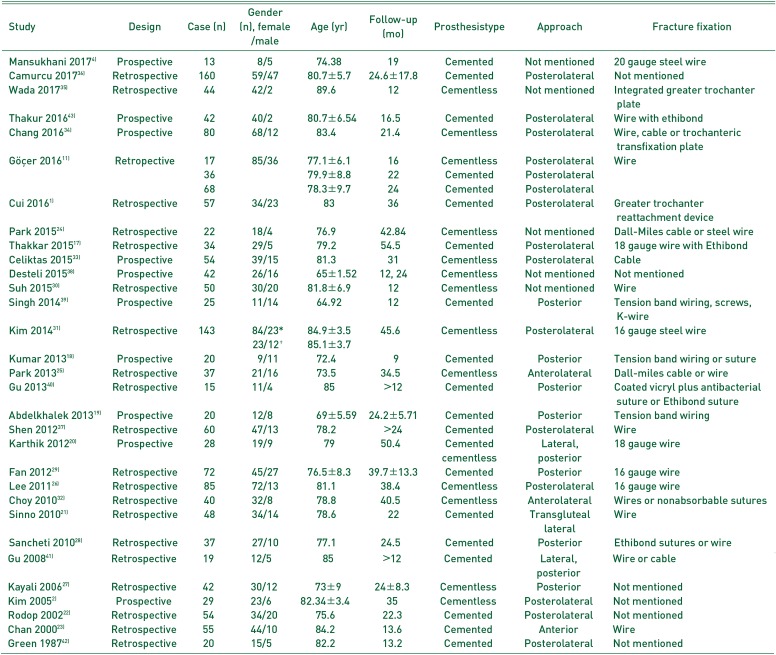
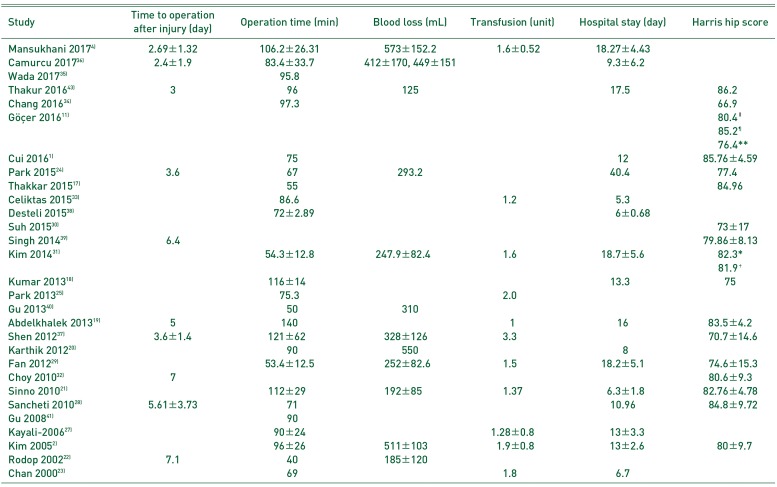




 PDF
PDF ePub
ePub Citation
Citation Print
Print



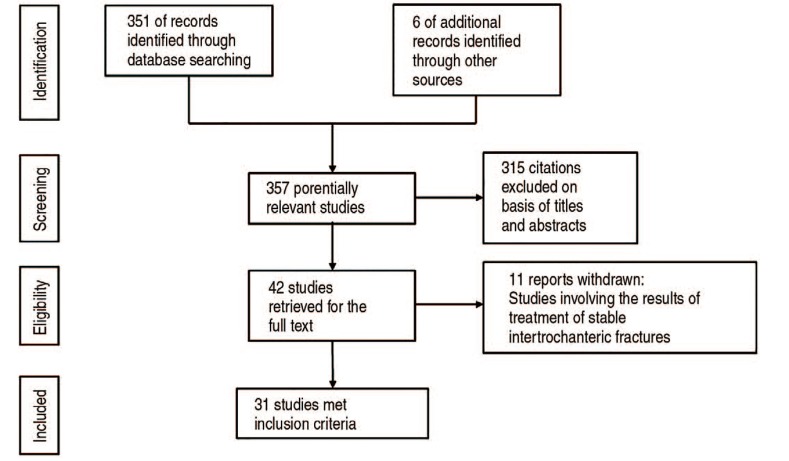

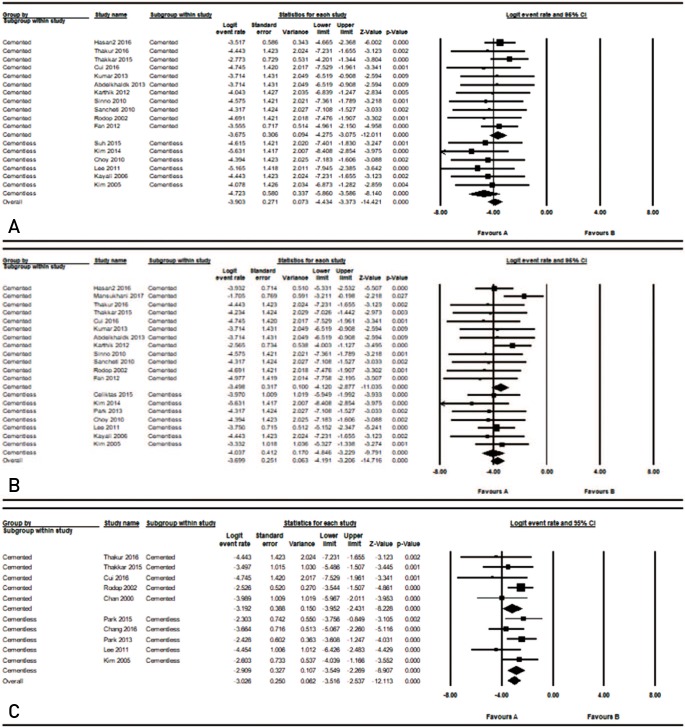
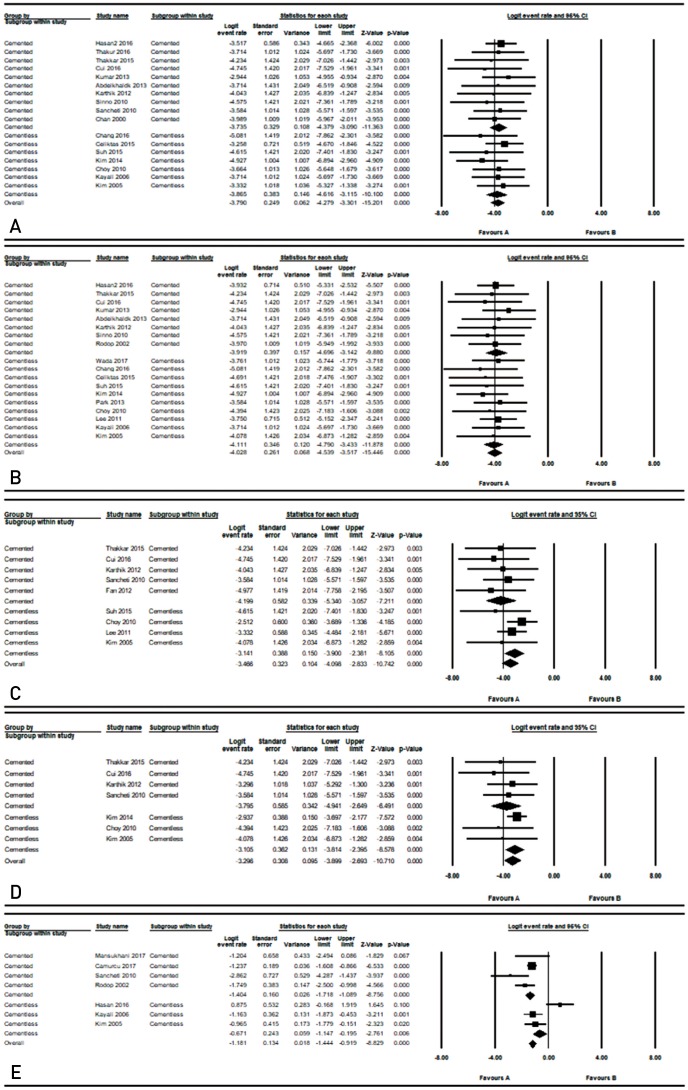
 XML Download
XML Download